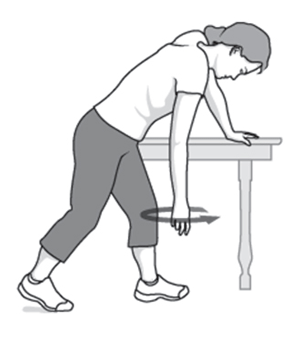Shoulder pain or restriction?
You are not alone.
Shoulder pain is a very common condition at all ages but increasingly occurs as we get older. One in five over 65s will be dealing with some sort of shoulder stiffness, pain or impingement.
What can you do about it?
If you are in severe discomfort or pain (for example if it affects your sleep) you need to see a physio.
If the pain is less serious or ‘on the mend’, the best thing to do is gentle mobility movements.
Two examples are:
- Rolling the shoulder forwards and backwards 5 or 6 times

- Using a table or chair for support with your ‘good’ arm then letting your ‘bad’ arm relax and hang down perpendicular to the floor. From there imagine you are ‘stirring the porridge’. Go both directions and repeat 5-6 times.
Do these exercises several times during the day.
What movements should we take care with?
You may have heard of a group of muscles known as the rotator cuff muscles. (Small muscles that work to stabilise the shoulder so that the larger muscles can work effectively.) The problem is that some repetitive movements put them in a very weak position and they get injured as a result.
Three examples of very common everyday things we do but should modify to protect our shoulders are:
- Reaching back with your hand closest to the window for your seat belt, whether you are driving or if you are a passenger. This is a terrible position for your shoulder! A much safer way of belting up is to reach across your body to pull down the belt, using your opposite hand.
- Reaching up to open or close something like a garage door.
- Ladies – putting your bra on by reaching around behind to do up the hooks. It’s kinder to your shoulder to do up the hooks at the front then turn the bra.
__________________________________________________________






will try these shoulder exercises. Ive had shoulder problems before and had physio but improvement didn’t last.
Thanks for the shoulder tip. I occasionally have shoulder problems so will be using these tips as needed.